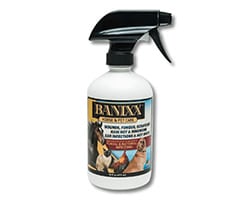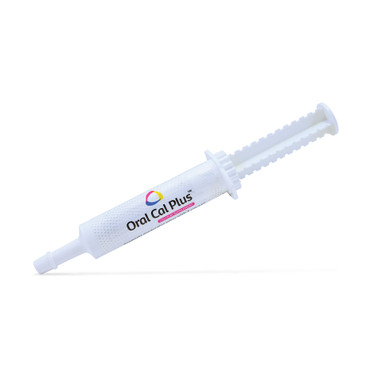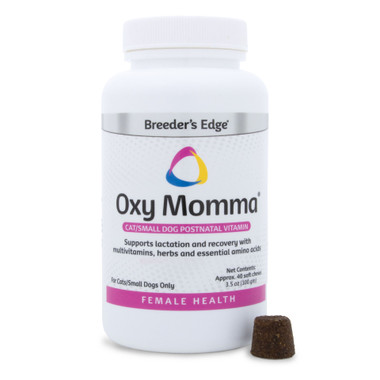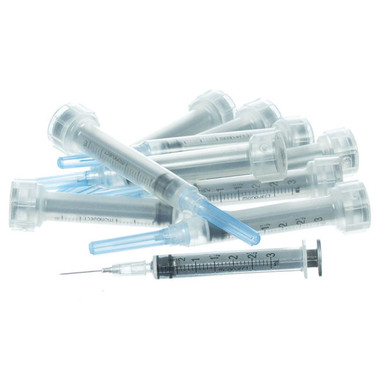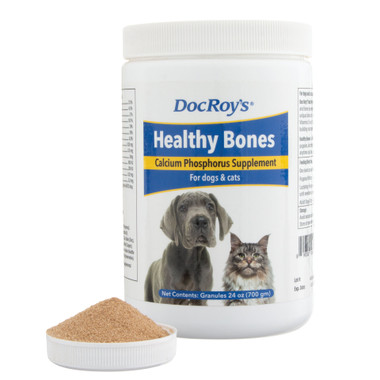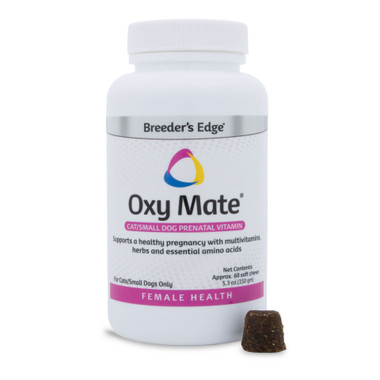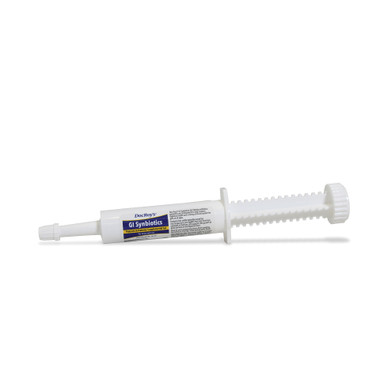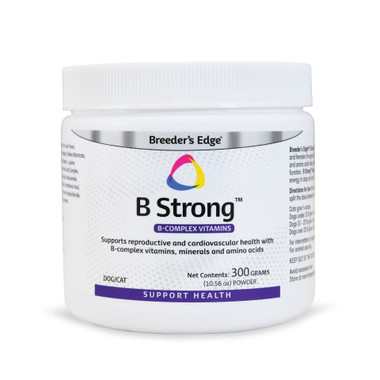Battling Botulism in Horses – Is my Horse in Danger?
Estimated 0 min read
Botulism in Horses – What you Need to Know
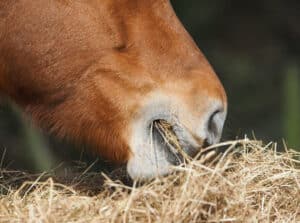
Could your horse’s hay be a culprit to botulism?
This disease is relatively uncommon, but it’s important to know what to look for.
When news headlines highlighted a batch of processed forage leading to cases of botulism in horses, the questions arise: what is botulism? How does it affect my horse? What are the signs of botulism in horses? How worried should we be as horse owners? How do I prevent this? Veterinarian Dr. Rudy Madrigal at Equine Sports Medicine & Surgery in Weatherford, Texas, shares his insights on this neurologic disease.
What is botulism?
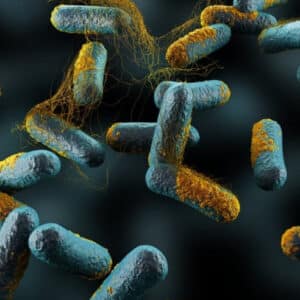
Clostridium botulinumproduce toxins
Botulism is a bacterial infection in which a toxin is produced. The most usual way that a horse contracts Botulism is viaeating feed that is contaminated with toxin already in it.This arises either from the ingestion of spoiled feed or feed contaminated with an animal carcass.Madrigal says there are seven types of toxins that stem from this infection, but only three are known to affect horses:Clostridium botulinumtypes A, B and C.
“We see the B toxin cases most commonly on the East Coast, Kentucky and in the more Northeastern states,” Madrigal said. “The A toxin cases are more of the Western states, is where you’ll see them. The C toxin is probably most commonly seen in Florida, and sporadically in other areas. That’s the one most often seen in animal carcasses.”
The toxin binds to neuroreceptors in the body, and most commonly results in flaccid paralysis. The result? Often, rapid death due to the paralysis and collapse of vital organs.
“This means that the nerve conduction is unable to happen, and the result is the horses get weak,” Madrigal continued “It gets progressively worse, and the severity is very dependent upon when you start treating them, and how much toxin they ingest.”
How can a horse contract botulism?
In fact, there are two main ways a horse can acquire botulism: infection of a wound and ingestion. However, this disease is not passed directly from horse to horse, or from horses to humans. But if several horses are consuming the same infected feed they may all succumb. Then you have a botulism outbreak.
“Contaminated feed is the most common method of contracting botulism, whether because it was improperly stored and it held too much moisture, which allows the bacteria to grow in there. Or if it’s been contaminated by a carcass that had botulism,” Madrigal disclosed.
Symptoms
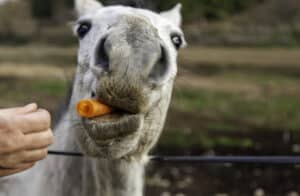
Horses with botulism have a difficult time swallowing
Some of the early signs of botulism in a horse include the horse being unable to swallow or retract their tongue, Madrigal added. Additionally, they may have difficulty standing.
“They may also have weak eyelids—they may be unable to really open up their eyelids,” Madrigal said.
The horse’s condition will deteriorate with increased exposure to the toxin, Madrigal stated.
“As they ingest more toxin, they’ll continue to get weaker and weaker, until they become recumbent, or are unable to stand,” Madrigal told us “Usually once that happens, the most common thing to do, or the best thing to do for them, is to, unfortunately, put them down. These horses are unable to clear the toxin in a quick enough manner to recover.”
Diagnosis
Historically, the diagnosis of botulism presented difficulties as it was performed using a mouse bioassay. This meant that samples from affected patients were injected into mice and each mouse was treated with antitoxins. Thus, an antitoxin to each type of botulism was administered to help identify the toxin type. Madrigal went on to say newer testing including polymerase chain reaction (PCR) can help find the DNA for each toxin type. However, few laboratories are currently performing this testing.
Treatment
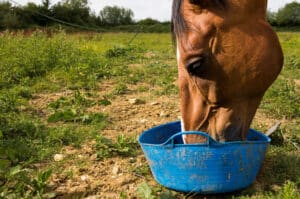
Be mindful of feed selection
Furthermore, Madrigal revealed that the only treatment available for horses is administering plasma with an antitoxin, paired with supportive care. The disease cannot be reversed. Sadly, there is no way to make the toxin release from the neuroreceptors. But, with time, they can slowly release on their own, Madrigal disclosed.
“Foals tend to have a better outcome, but foals may end up needing to be put on ventilators,” Madrigal declared. “But there’s no good way to keep an adult horse on a ventilator.”
To begin with, Botulism starts affecting a horse’s ability to contract its muscles, and it first affects the muscles needed to stand, Madrigal disclosed.. Once the muscles are affected, horses are unable to stand, leading to recumbence. Then the muscles required for respiration become affected leading to asphyxiation. Once a horse has become recumbent, chances of survival are extremely low.
“If you get plasma into the horse, you’re hoping to stop progression of the disease. But you will not be able to reverse the clinical signs,” Madrigal replied. “So, for some of these horses, as long as they’re still standing and eating, we can keep them going. However, if they’ve already progressed to have clinical signs of difficulty swallowing, that can take weeks to resolve. They can fully recover, but it takes time.”
Prevention
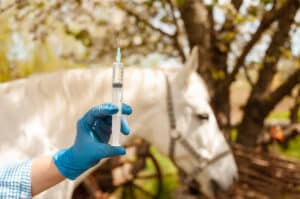
Horse getting toxin B vaccine
Luckily, there is a vaccine to cover toxin B, so horse folks can vaccinate against this strain of botulism, Madrigal informed us. This is helpful in areas where botulism is common. It’s particularly expedient when given to mares in the last three months of pregnancy. Thus, it gives foals immunity to that one strain.
In fact, the only other method of prevention is keeping a close eye on your feed selection. In particular to manufactured feed and hay.
“Try to choose feed that has been well-maintained from a forage point is the main thing,” Madrigal said.
Fortunately, botulism is not very common in horses. The current outbreak in alfalfa cubes is a rarity, says Madrigal.
“Here in Texas, we don’t really see [botulism] because we feed round bales and square bales, and it’s not commonly seen in that forage source,” Madrigal reported.
Your best bet is to pay attention to signs in your horse of neurological issues, principally with eating and drinking habits.
“The earlier you catch it, the better results you’ll get, if you’re then able to treat it,” Madrigal stated.
In summary, as with any horse disease, vigilance is vital. We can’t always know what our horses consume. Whether they are boarded or at your own facility, some hay could be tainted or some feed contaminated and you may never be aware. It happens.
Banixx for Horse Lovers
We hope that this short blog helps you understand the disease so that you can be on the defense for your horse’s health. Our large variety ofhorse blogscovers a myriad of equine questions: check us out! We cover more serious topics such asEPMorLyme Diseasebut then we also talk aboutEinstein, the World’s Tiniest Horse! Stay with us for more helpful or fun blogs!
ByAbigail Boatwright
This article is published courtesy of Barrel Horse News
Sources
largeanimal.vethospitals.ufl.edu/botulism-mammals
msdvetmanual.com/horse-owners/infectious-diseases-of-horses/botulism-in-horses



